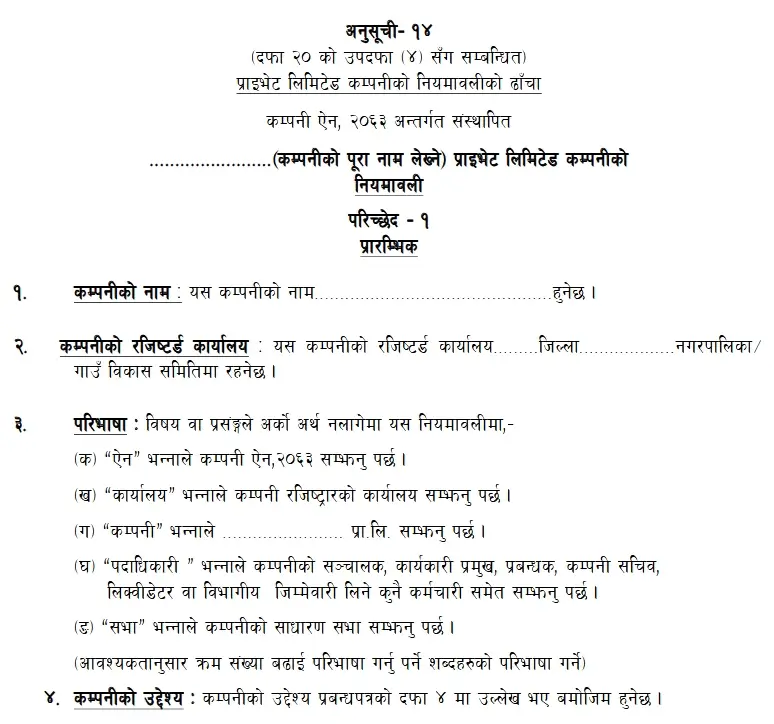Starting a business in Nepal? One of the most important documents you’ll need during company registration is the Articles of Association (AOA) — known in Nepali as “नियमावली (Niyamawali)”.
The AOA defines the rules, objectives, and internal management system of your company. It acts as a legal guide that governs how the company operates, makes decisions, and handles members’ rights and responsibilities.
In this blog, we’ll explain how to draft the Articles of Association (AOA) in Nepali step-by-step, as per the Companies Act, 2063 (2006).

Steps to Draft Articles of Association (AOA) in Nepali
Here are the full steps to prepare your AOA document properly:
Step 1: Study the Companies Act, 2063
Before drafting, understand the Companies Act, 2063 (2006), especially sections related to AOA. It gives a clear idea of what must be included and what is not allowed.
Step 2: Use the Prescribed Format
The Office of the Company Registrar (OCR) provides a sample Articles of Association (AOA) format for both private and public companies. We have also listed a sample AOA format below. You can use this format as a base and modify it according to your company type and requirements.
| Articles of Association | Sample Format |
|---|---|
| AoA for Private Limited Company | Download PDF |
| AoA for Public Limited Company | Download PDF |
Step 3: Write in Nepali Language
As per OCR rules, AOA and MOA should be written in Nepali language.
Make sure to:
- Use clear and simple Nepali
- Avoid legal or confusing jargon
- Ensure that all company objectives and rules are clearly written
Step 4: Include the Key Clauses
Your AOA should include the following sections:
- Company Name and Address (कम्पनीको नाम र ठेगाना)
- Mention the registered name and office address.
- Objectives of the Company (कम्पनीको उद्देश्यहरू)
- List all business objectives in detail.
- Share Capital (पुँजी संरचना)
- Authorized, issued, and paid-up capital.
- Number and value of shares.
- Shareholders’ Rights and Liabilities (सेयरधनीहरूको अधिकार र दायित्व)
- Voting rights, dividend rights, and liabilities.
- Board of Directors (निर्देशक मण्डल)
- Number of directors, appointment process, and responsibilities.
- Meetings (बैठकहरू)
- Procedures for board meetings and annual general meetings (AGMs).
- Accounts and Audit (लेखा र अडिट)
- Financial year, record keeping, and auditor appointment.
- Share Transfer Rules (सेयर स्थानान्तरणका नियमहरू)
- Procedures for selling or transferring shares.
- Dividend and Reserve (लाभांश र जगेडा कोष)
- How profits will be distributed and reserves maintained.
- Company Seal and Signature (छाप र दस्तखत)
- Official seal and signature authority.
Step 5: Get Approval from Founding Shareholders
After drafting, all founding shareholders must review and sign the AOA.
Each page should be initialed (दस्तखत) by the shareholders.
Step 6: Submit to the Office of Company Registrar (OCR)
Attach the signed AOA with:
- Memorandum of Association (MOA)
- Application Form
- Copy of Citizenship Certificates
Then submit these documents online through OCR’s portal or physically at their office.
Step 7: Make Amendments (if required)
If OCR suggests any corrections, edit your AOA accordingly.
Once approved, it becomes a legal and binding document for your company.
If you are not sure how to create or update your AoA, Company Sewa can help you.
Take an Expert Guidance
Connect with Mr. Dipendra Shah, bringing 10 years of experience to guide you.
Contact No. / Whatsapp: +977 - 9851253180
